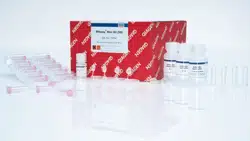Loading ...
Loading ...
Loading ...

72
RNeasy Mini Handbook 10/2019
Issue
Comments and suggestions
e) Storage duration in
RNAprotect Tissue
Reagent exceeded
RNAprotect stabilized tissue can be stored for up to 1 day at 37°C, up to 7 days at
15–25°C, or up to 4 weeks at 2–8°C, and can be archived at −30 to −15°C or
−90 to −65°C.
f) Inappropriate handling of
starting material
Ensure that tissue samples are properly stabilized and stored in RNAprotect Tissue
Reagent.
For frozen cell pellets or frozen tissue samples, ensure that they were flash-frozen
immediately in liquid nitrogen and properly stored at −90 to −65°C. Perform the
RNeasy procedure quickly, especially the first few steps.
See Appendix A (page 73), “Handling and storing starting material” (page 20),
and the RNAprotect protocol (page 41).
g) RNAse contamination
Although all RNeasy buffers have been tested and are guaranteed RNAse-free,
RNAses can be introduced during use. Be certain not to introduce any RNAses
during the RNeasy procedure or later handling. See Appendix A (page
73) for
general remarks on handling RNA.
Do not put RNA samples into a vacuum dryer that has been used in DNA
preparations where RNAses may have been used.
DNA contamination in downstream experiments
a) Optimal procedure not
used (cell samples)
For animal cells, we recommend purifying cytoplasmic RNA for applications where
the absence of DNA contamination is critical, since intact nuclei are removed at the
start of the procedure. The protocol can be downloaded at
www.qiagen.com/resources/RNeasyMini.
b) No incubation with Buffer
RW1
In subsequent preparations, incubate the RNeasy spin column for 5 min at room
temperature after addition of Buffer RW1 and before centrifuging.
c) No DNase treatment
Perform optional on-column DNase digestion using the RNAse-Free DNase Set (see
Appendix D, page 82) at the point indicated in the individual protocols.
Alternatively, after the RNeasy procedure, DNase digest the RNA eluate. After
inactivating the DNase by heat treatment, the RNA can be either used directly in the
downstream application without further treatment, or repurified using the RNA
cleanup protocol (page 67).
RNA does not perform well in downstream experiments
a) Salt carryover during
elution
Ensure that Buffer RPE is at 20–30°C.
When reusing collection tubes between washing steps, remove residual flow-through
from the rim by blotting on clean paper towels.
b) Ethanol carryover
During the second wash with Buffer RPE, be sure to centrifuge at ≥8000 x
g
(≥10,000 rpm) for 2 min at 20–25°C to dry the RNeasy spin column membrane.
After centrifugation, carefully remove the column from the collection tube so that the
column does not contact the flow-through. Otherwise, carryover of ethanol will
occur.
To eliminate any chance of possible ethanol carryover, place the RNeasy spin
column in a new 2 ml collection tube and perform the optional 1 min centrifugation
step as described in the protocols.
Loading ...
Loading ...
Loading ...
